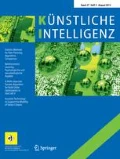Abstract
In this thesis we study KLM-style rational reasoning in defeasible Description Logics. We illustrate that many recent approaches to derive consequences under Rational Closure (and its stronger variants, lexicographic and relevant closure) suffer the fatal drawback of neglecting defeasible information in quantified concepts. We propose novel model-theoretic semantics that are able to derive the missing entailments in two differently strong flavours. Our solution introduces a preference relation to distinguish sets of models in terms of their typicality (amount of defeasible information derivable for quantified concepts). The semantics defined through the most typical (most preferred) sets of models are proven superior to previous approaches in that their entailments properly extend previously derivable consequences, in particular, allowing to derive defeasible consequences for quantified concepts. The dissertation concludes with an algorithmic characterisation of this uniform maximisation of typicality, which accompanies our investigation of the computational complexity for deriving consequences under these new semantics.

Notes
For a detailed introduction to DLs we refer to [2].
These advanced closure operators are alleviating the drawback of Rational Closure known as inheritance blocking.
Formally, an inclusion \(BrokenWing\sqcap Fly\sqsubseteq \bot\) is required to imply inconsistency of tweety with Bird
 Fly.
Fly.Formally, the set of all typicality models is finite, hence there are no infinite chains through \(<_t\).
References
Baader F, Brandt S, Lutz C (2005) Pushing the \({\cal{EL}}\) envelope. In: Proceedings of the 19th int. joint conference on artificial intelligence, IJCAI, pp 364–369
Baader F, Horrocks I, Lutz C, Sattler U (2017) An introduction to description logic. Cambridge University Press, Cambridge
Bonatti PA, Faella M, Petrova IM, Sauro L (2015) A new semantics for overriding in description logics. Artif Intell 222:1–48. https://doi.org/10.1016/j.artint.2014.12.010
Casini G, Meyer T, Moodley K, Nortje R (2014) Relevant closure: a new form of defeasible reasoning for description logics. In: Logics in artificial intelligence—14th European conference, JELIA, pp 92–106. https://doi.org/10.1007/978-3-319-11558-0_7
Casini G, Meyer T, Straccia U (2018) A polynomial time subsumption algorithm for nominal safe \({\cal{ELO}}_{\bot }\) under rational closure. Inf Sci. https://doi.org/10.1016/j.ins.2018.09.037
Casini G, Straccia U (2010) Rational closure for defeasible description logics. In: Logics in artificial intelligence—12th European conference, JELIA, pp 77–90. https://doi.org/10.1007/978-3-642-15675-5_9
Casini G, Straccia U (2012) Lexicographic closure for defeasible description logics. In: Proceedings of the 8th Australasian ontology workshop, pp 28–39
Casini G, Straccia U (2013) Defeasible inheritance-based description logics. J Artif Intell Res 48:415–473. https://doi.org/10.1613/jair.4062
Giordano L, Gliozzi V, Olivetti N, Pozzato GL (2015) Semantic characterization of rational closure: from propositional logic to description logics. Artif Intell 226:1–33. https://doi.org/10.1016/j.artint.2015.05.001
Kraus S, Lehmann DJ, Magidor M (1990) Nonmonotonic reasoning, preferential models and cumulative logics. Artif Intell 44(1–2):167–207. https://doi.org/10.1016/0004-3702(90)90101-5
Lehmann DJ, Magidor M (1992) What does a conditional knowledge base entail? Artif Intell 55(1):1–60. https://doi.org/10.1016/0004-3702(92)90041-U
Peñaloza R, Sertkaya B (2017) Understanding the complexity of axiom pinpointing in lightweight description logics. Artif Intell 250:80–104. https://doi.org/10.1016/j.artint.2017.06.002
Pensel M (2019) A lightweight defeasible description logic in depth—quantification in rational reasoning and beyond. Ph.D. thesis, Dresden University of Technology, Germany
Pensel M, Turhan AY (2017) Including quantification in defeasible reasoning for the description logic \({\cal{EL}}_{\bot }\). In: Logic programming and nonmonotonic reasoning, 14th int. conference, LPNMR. Springer, pp 78–84. https://doi.org/10.1007/978-3-319-61660-5_9
Pensel M, Turhan AY (2017) Making quantification relevant again—the case of defeasible \({\cal{EL}}_{\bot }\). In: Proceedings of the 4th int. workshop on defeasible and ampliative reasoning—DARe. CEUR-WS.org
Pensel M, Turhan AY (2018) Reasoning in the defeasible description logic \({\cal{EL}}_{\bot }\)—computing standard inferences under rational and relevant semantics. Int J Approx Reason 103:28–70. https://doi.org/10.1016/j.ijar.2018.08.005
Rector AL, Bechhofer S, Goble CA, Horrocks I, Nowlan A, Solomon D (1997) The grail concept modelling language for medical terminology. Artif Intell Med 9(2):139–171
Spackman K (2000) Managing clinical terminology hierarchies using algorithmic calculation of subsumption: experience with snomed-rt. J Am Med Inform Assoc, Fall Symposium Special Issue
Varzinczak IJ (2018) A note on a description logic of concept and role typicality for defeasible reasoning over ontologies. Log Univers 12(3–4):297–325. https://doi.org/10.1007/s11787-018-0211-x
Acknowledgements
This work was supported by the German Research Foundation (DFG) in GRK 1763—Quantitative Logics and Automata.
Author information
Authors and Affiliations
Corresponding author
Rights and permissions
About this article
Cite this article
Pensel, M. A Lightweight Defeasible Description Logic in Depth. Künstl Intell 34, 527–531 (2020). https://doi.org/10.1007/s13218-020-00644-z
Published:
Issue Date:
DOI: https://doi.org/10.1007/s13218-020-00644-z


 Fly.
Fly.